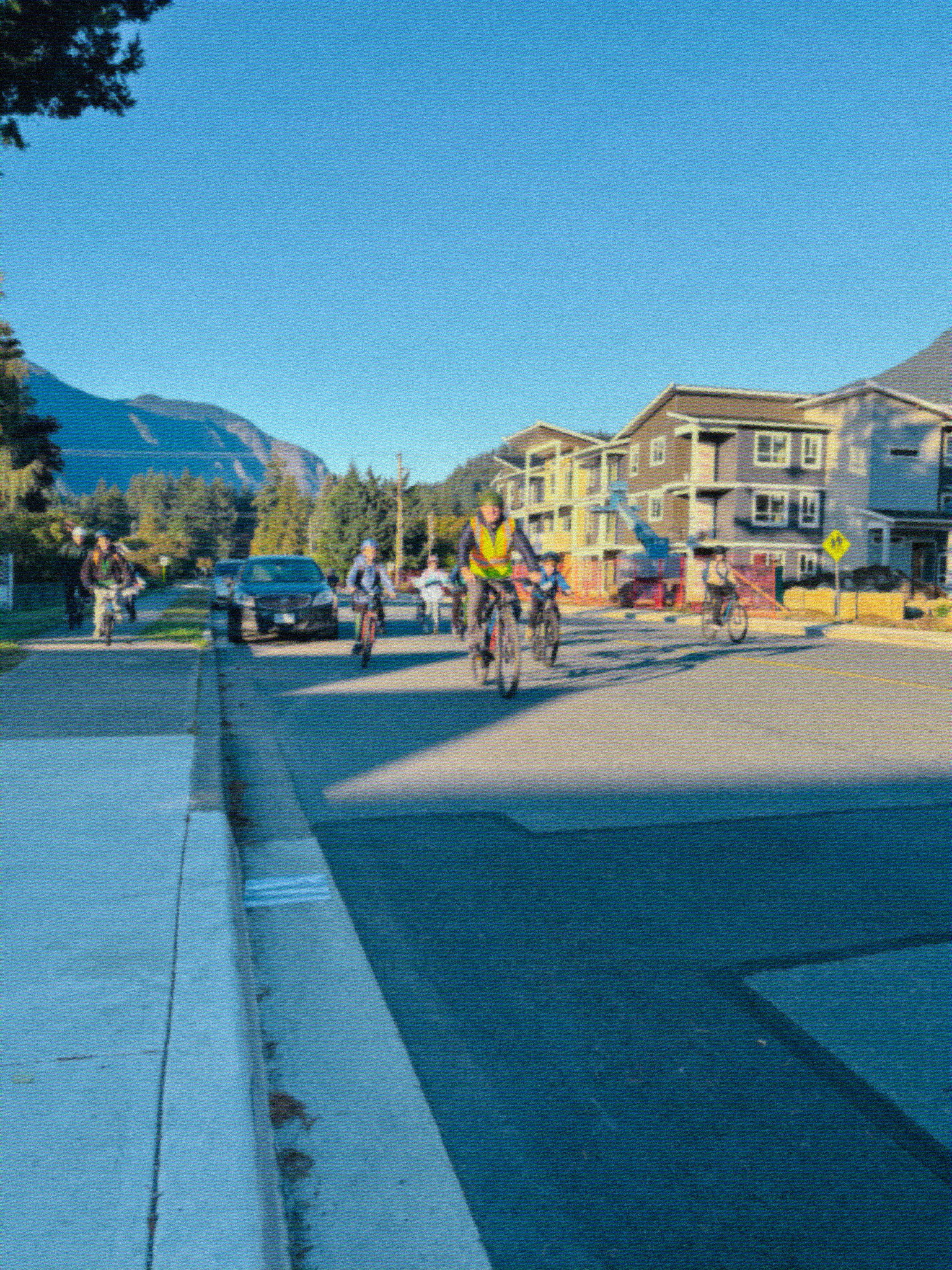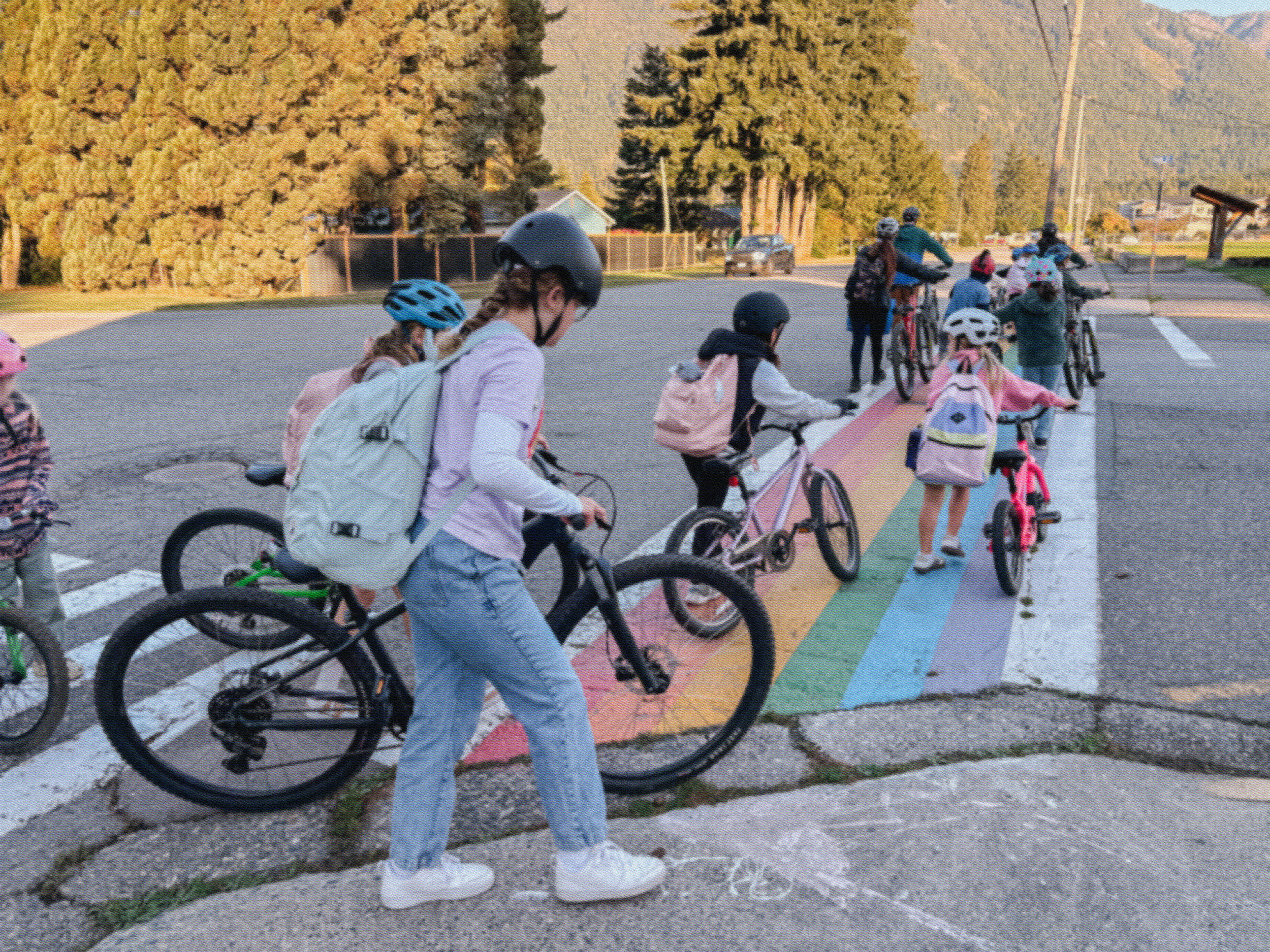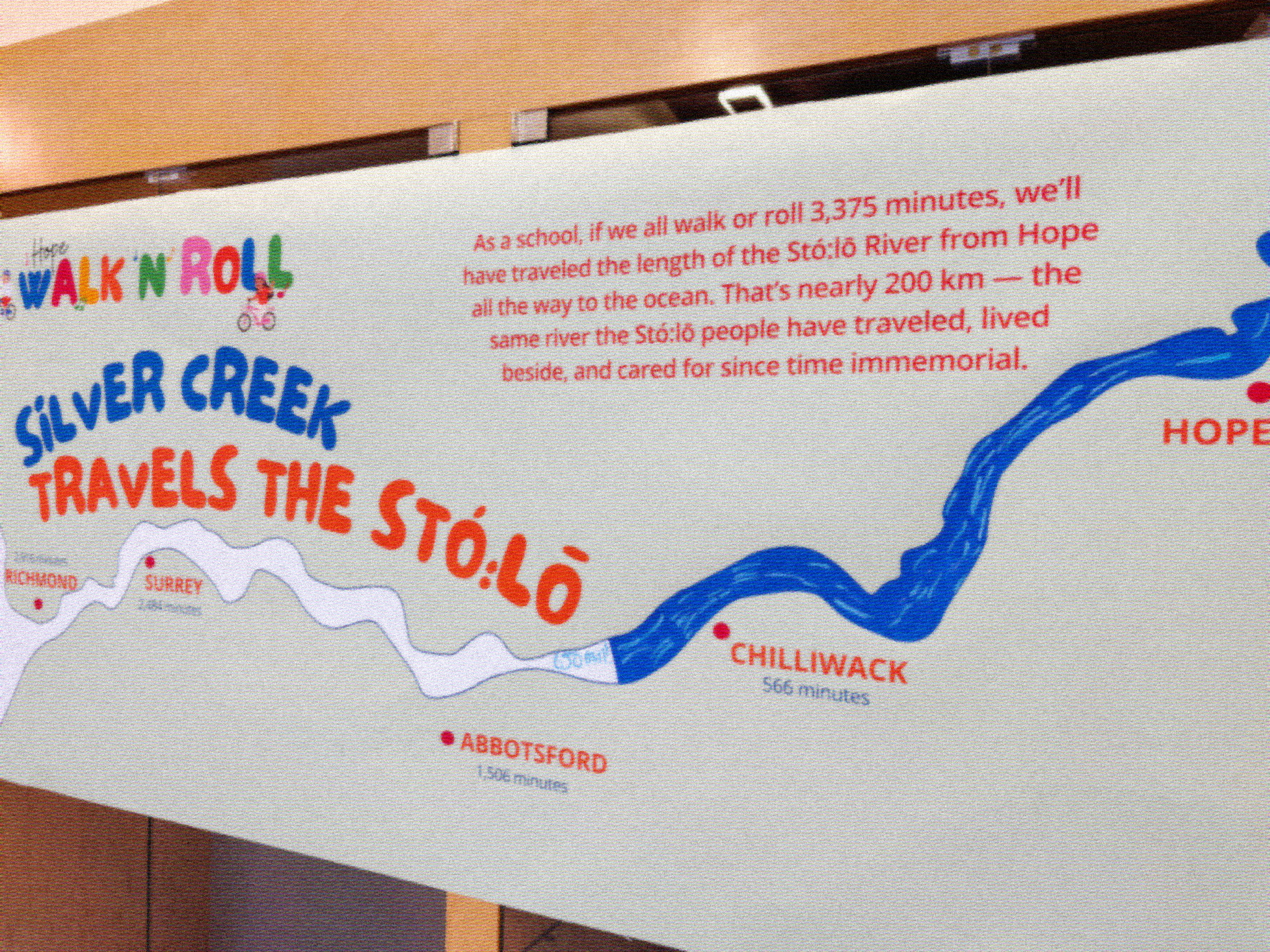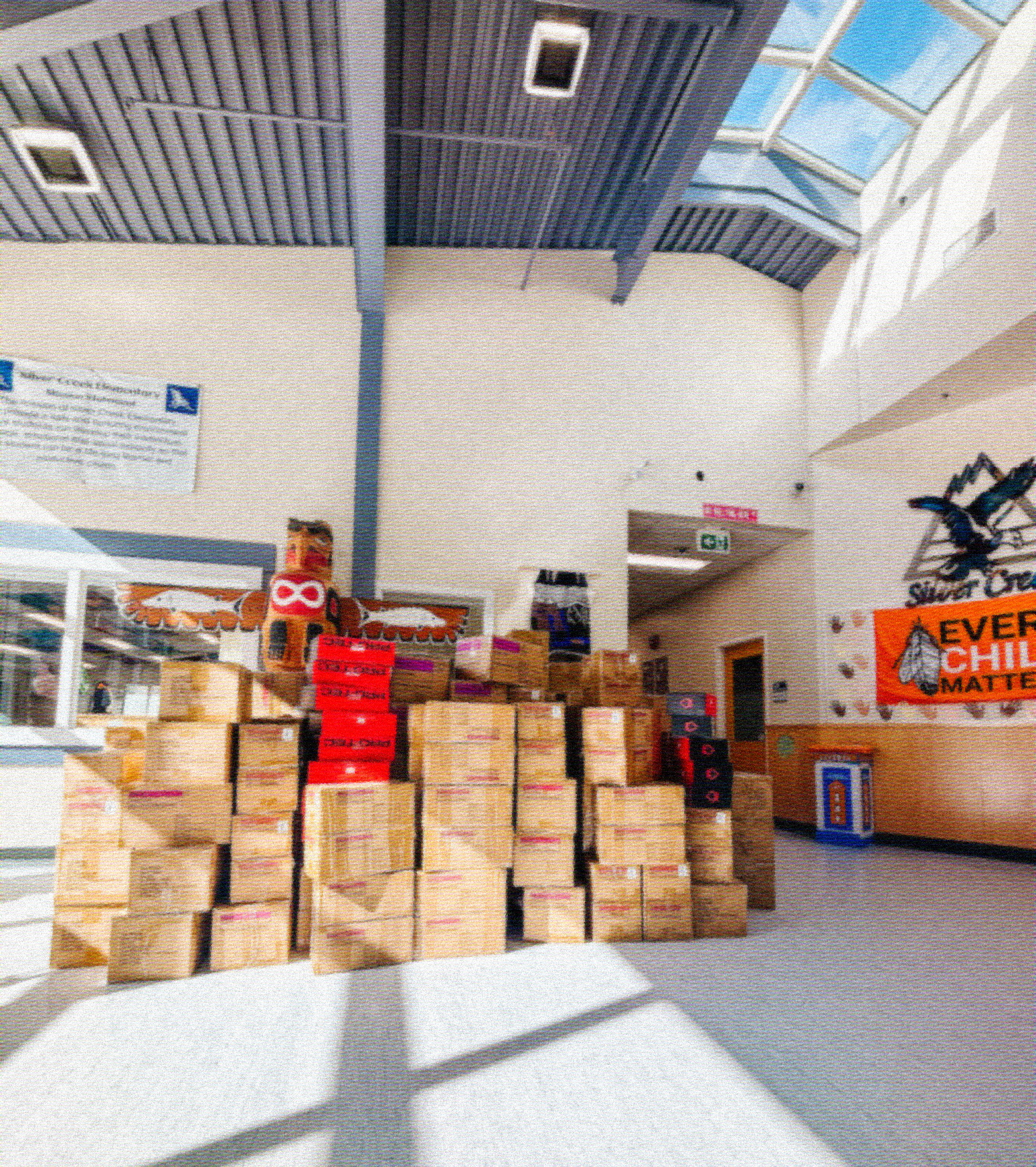Piloting Safer Streets:
HOW THE HOPE WALK ‘N’ ROLL STRENGTHENED LOCAL ACTIVE TRANSPORTATION
Helping children feel safer — and more connected — as Hope shifts toward active travel.
the partner
Serving communities from Harrison Hot Springs and the District of Kent through to Hope, Yale, and Boston Bar, School District #78 Fraser-Cascade is committed to fostering a love of learning, integrity, and respect for all students. Within the District of Hope, two elementary schools — Silver Creek Elementary and Coquihalla Elementary — are dedicated to creating safe, welcoming environments that support the well-being of their students and families.
the challenge
Both Silver Creek Elementary and Coquihalla Elementary are located in high-traffic areas, placing children who walk, bike, or roll to school at increased risk. From 2019 to 2023, 440 crashes were reported in the District of Hope — and 58% occurred within one kilometre of the two elementary schools. The accidental demolition of a pedestrian overpass near Silver Creek Elementary further heightened concerns for student safety, with many children now crossing a busy roadway without adequate infrastructure.
At the same time, local data shows that active school travel is not accessible for many families. According to the Middle Years Development Instrument, only 1% of Grade 5 students in the district bike, skateboard, scooter, or rollerblade to school — even though 10% wished they could. Many students rely on car travel, contributing to congestion around school zones and reinforcing safety challenges.
These patterns reflect broader trends: rural communities and lower-income families face greater barriers to safe active travel, including lower rates of helmet use and limited access to safety equipment. In Hope, these factors intersect with limited infrastructure, socioeconomic inequities, and the realities of a rural environment, creating conditions where children who want to bike or roll simply cannot do so safely.
With funding from the Vision Zero Road Safety Grant, the schools piloted two new approaches that strengthen safety, connection, and equitable access to school.
The Hope Walk ’n’ Roll was developed through this collaboration, supporting safer routes to school and helping build a stronger culture of active travel for children and families in Hope.
goals
Reduce traffic congestion in school zones by encouraging students and families to walk, bike, or roll instead of relying on car travel.
Increase safety for vulnerable road users through supervised bike bus routes, visible adult helpers, and improved awareness of road safety practices.
Improve access to safety equipment and information by distributing helmets and protective gear and sharing bike safety guidance with families.
Begin building a stronger culture of active travel by helping children experience walking and rolling as safe, enjoyable, and socially supported.
collaborators
Hope RCMP
EmpowerEd Support Services Society

the groundwork for community building
In a rural community like Hope, the journey to school is more than a daily routine — it’s a reflection of safety, connection, and the supports children can rely on as they move through their neighbourhoods. Before the Hope Walk ’n’ Roll began, many students wished they could walk or bike to school, but are unable to wether it’s for safety, due to the rush of the morning, or lack of accessible options. Safety concerns, missing infrastructure, and the expectation that driving is the norm all shaped how children and families moved.
Active school travel has the power to shift these patterns. Research consistently shows that when children walk or roll to school, they experience:
Healthier bodies and minds — better mood, improved sleep, stronger focus, and healthier hearts, lungs, and bones.
Safer school zones — reduced traffic congestion and vehicle emissions during peak hours.
Skills for life — confidence, resilience, spatial awareness, independence, and improved problem-solving.
More connected communities — increased social connection and trust, with benefits for children, families, and neighbours alike.
These benefits are meaningful in Hope, where nearly half of Grade 6 students report a medium to low sense of belonging at school — and where active travel can help strengthen relationships, confidence, and connection.
The Hope Walk ’n’ Roll was rooted in this understanding. By bringing educators, families, community helpers, and local partners together, the project created more than safer routes. It created moments of connection — kids moving together, adults showing up for them, schools and families working toward shared safety — and laid the groundwork for a community where children feel supported, confident, and connected on their way to school.
This is what 300 helmets and 100 pad sets looks like,
our process
Working closely with Fraser Health, Silver Creek Elementary, and Coquihalla Elementary, we designed and delivered a community-led pilot that helped students and families experience walking and rolling as safe, supported, and joyful. The work was rooted in collaboration — with school leadership, teachers, parents, and community partners — ensuring that every step reflected local realities and the needs of children.
We grounded each decision with boots-on-the-ground data collection. At the end of the ‘24/’25 school year, we surveyed parents and the community at large on travel habits to determine strengths, needs, and opportunities. Our team also walked the primary routes to school in order to note safety concerns and community opportunities. This data was shared with a cartographer to develop an Active School Travel Map for each of the participating elementary schools.
After data gathering and analysis, planning for the fall pilot began: securing safety equipment for students, preparing communication materials for families, and coordinating with community helpers, including the Hope RCMP and volunteers. With more than 300 helmets and 100 sets of protective gear distributed, families had what they needed to participate safely.
The first Walk ‘n’ Roll pilot week took place October 6–10, 2025. At Coquihalla Elementary, students were invited to take part in a morning Bike Bus — organized cycle rides that you can join or leave anywhere along the route. Each bike bus has a “Driver” (in our case, Principal Becker took the lead) who looks after the group, guiding riders across junctions along the route. Bike Busses make safety visible and help turn the journey to school into a shared community moment. These mornings provided more than supervision — they created connection points between children, families, and neighbours, transforming familiar streets into welcoming paths.
At Silver Creek Elementary, students were challenged to “Travel the Stó:lō” — a week-long walking and rolling challenge inspired by the land and waters that shape the Hope community. Instead of a fixed route or schedule, students set a shared goal of moving a cumulative 200 minutes over the week. Each minute represented a meaningful step in reconnecting with the land, building healthy habits, and experiencing their neighbourhoods with curiosity and confidence.
Classrooms tracked their collective progress, celebrated milestones together, and encouraged one another to keep going. The challenge gave students ownership over their movement, created space for teachers to weave conversations about place and well-being into the week, and offered families an approachable, flexible way to participate. For many students, it was a powerful reminder that active travel isn’t limited to one path or mode — it can be built into everyday life in ways that feel accessible, culturally grounded, and fun.
Throughout the pilot, we gathered observations and feedback from teachers, parents, volunteers, and students. This reflective loop helped us understand what made children feel safe, what moments sparked joy or hesitation, and what conditions supported a calm, confident start to the school day.
By centring care, communication, and community readiness, the process laid the foundation for sustainable change. Hope Walk ’n’ Roll became more than a pilot — it became a shared step toward safer streets, stronger relationships, and a growing culture of active travel in Hope.

“The Bike Bus quickly became the highlight of our students’ morning. They felt safe, supported, and excited to ride together. Thrive & Connect handled every detail — from safety planning to communication — with such care that it allowed us to focus on our students’ experience and well-being.”
-Bruce Becker, Principal of Coquihalla Elementary
the impact
52% reduction in morning traffic at Coquihalla Elementary during the pilot week, creating calmer and safer conditions for students walking and rolling to school.
300 helmets and 100 sets of protective gear distributed, increasing access to safe active travel for students across both schools, with 200 bike locks arriving for the second pilot.
Over 200 cumulative minutes of active travel completed by Silver Creek students during the “Travel the Stó:lō” challenge, strengthening confidence, movement, and connection to place.
Visible community engagement, with parents, caregivers, RCMP members, Fraser Health staff, and neighbourhood volunteers showing up to support students along the routes.
Reduced congestion and improved safety at school entry points.
Higher levels of student enjoyment and participation, with many students asking for the Bike Bus and walking challenges to continue beyond the pilot week. Principal Becker also observed an increase in students walking or rolling to school in the weeks leading up to the pilot, compared to previous school years.
Strengthened sense of connection and belonging, as students, families, and community helpers built relationships during the morning journey.
Momentum toward culture change, with families expressing interest in continuing active school travel as part of their regular routines.
now they thrive
By centering safety, connection, and community readiness, Hope Walk ’n’ Roll did more than reduce traffic or get more kids moving — it shifted what felt possible for families, schools, and the broader community. The project demonstrated that when children are supported with the right tools, trusted adults, and joyful community moments, active school travel becomes not only accessible, but desirable.
This pilot laid the foundation for long-term change. Both schools now have the data, tools, and confidence needed to continue active travel initiatives, including:
custom Active School Travel Maps to guide route planning and safety improvements
strengthened partnerships with Fraser Health, the Hope RCMP, and local volunteers
increased familiarity, comfort, and interest among students and families in walking and rolling to school
What made this project transformative was not just the programming — it was the approach. Thrive & Connect brought relational project management, community-engaged facilitation, and an equity lens that honoured local context and created space for families, educators, and neighbours to participate meaningfully. By focusing on safety, dignity, and connection, the work helped build trust between partners and inspired new commitments to active travel and safe streets.
At its core, this case study demonstrates that when safety initiatives are designed with care, collaboration, and a deep understanding of community realities, they can do more than improve infrastructure — they can strengthen relationships, shift culture, and create the conditions where children and families can truly thrive.






